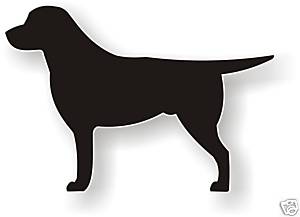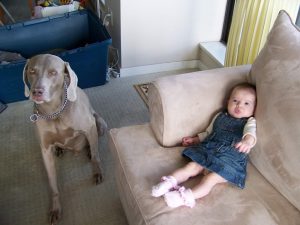Researches have studied the family dog influences your baby’s development for the last several years. Each time new evidence comes to light. The family dogs and baby’s development is a growing area of research. To know how babies benefit from having a family dog, we need to understand how they process their world very early on. One of the ways human infants learn language and speech is through repetition of sounds and verbal ques. Over just a few months, their minds use that information to build simplistic categorization strategies. All babies typically start to build categories around four months old. These categories are very early beginnings of brain development and become more sophisticated as the child grows. The infant needs many repetitive personal and environmental interactions to consolidate their cognitive development. Babies need experience through sight, sound and touch to make sense of their world.
Baby’s Brain Organizes The World In Categories
 |
| As early as 6 months of age, an infant with a dog at home can recognize the above image as representing a generic appearance of a dog |
By six months old, babies with family dogs at home were able to recognize the general appearance of a dog, more consistently than those who did not have a dog. However, they could only recognize the image if the dog was right-side up, standing on all fours. If the image was flipped around, with the dog’s feet pointing up and the dog’s back down, the infant could not associate the image with the “dog” category they previously formed. Likely, because they were not familiar with this dog pose in reality. As early as the baby’s first few months of life, the family dog influences a baby’s development.
How Babies Learn About Their World
You might wonder how the researchers knew how babies learn about their world. The family dog influences baby’s development by enhancing their small world. The researches evaluated the infant`s ability to recognize simple, high contrast dog images. Recognition was based on the infants reactions to the images. Black and white images are really clear for infants to see at 6 months of age because of the sharp contrast. The researches acted in the infants best interests by understanding eye development, and using images that worked well for the babies developmental abilities. The babies either reacted excitedly, by cooing more, kicking their legs, and looking at the picture of the top image for a shorter amount of time. When shown the inverted dog image (bottom, above) babies `looked` at the picture longer and did not react with excitement. Non-excitement was based on – no physical response such as leg kicking, and there was no direct verbal response such as increased cooing. To assess for less familiarity to the image, the babies were observed for increased interest, but lack of physical response.
Babies looked at the top image of the dog (above) for less time than the bottom image of the inverted dog. Illustrating that the babies had some level of recognition to the image and found it common place so did not need to focus on it for a prolonged amount of time. The researches also used an image of a generic cat in comparison to the generic dog and produced the expected results that they stared longer at the cat image than at the dog image. This was consistent with the evidence that they had a dog at home that they interacted with daily, not a cat. It was found that the infants would stare at the image for a shorter amount of time if they were more familiar with it, and they looked at other images longer if they were less familiar with it.
Baby Has Personality at Six Months
As a parent, if you have had a six month old, you can remember how their personality is beginning to emerge at this time. You can remember how they reacted to many things they liked. As a parent, it is easy to tell if your baby is pleased or displeased with environmental experiences. You know that babies react to pleasant music that they enjoy. You know that they may startle and to a loud unpleasant noise, or turn away from something they don’t like . Their responses can be very obvious and accurate even at such a young age.
 |
Infants also needed to be able to recognize how the dog’s ears, eyes, nose and mouth appeared in order to build the category. The infants did this effectively through daily interactions and experience with their family dog.
These infants were also able to make simple modifications to the category over time as they gained new information from their early life experiences. Such as seeing different breeds on walks. Dogs with pointed ears versus dogs with floppy ears challenged their development of the category and the infant, over time, with repeated exposure is able to adjust their category development and reasoning appropriately.
Click the video below to see how Researchers at the University of British Columbia (UBC) conducted a study on dogs and infant development in 2018.
What About Infants Without Dogs at Home
For infants growing up without a family dog, there is no need for panic. Although family dogs help babies develop “dog” categories earlier, cognitive development usually levels out by pre-school and early elementary as children without dogs at home learn from observing dogs from the surrounding environment. What research can tell us is infant’s learning is context dependent.
Therefore, repetitive, consistent, physical and observational experience leads to quicker learning and formation of categorization in early infancy. This process is aided by parental interest and encouragement.
Supportive Early Environment Prevents Adverse Childhood Effects (ACE’s)
Do Family Dogs Help ACE’s?

